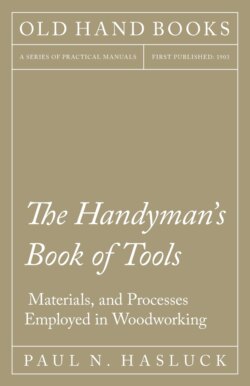Читать книгу The Handyman's Book of Tools, Materials, and Processes Employed in Woodworking - Paul N. Hasluck - Страница 46
На сайте Литреса книга снята с продажи.
CRAMPING CIRCULAR WORK.
ОглавлениеThere will now be explained away many of the difficulties in closing or cramping the joints in circular work, such as chair-seat frames, circular rims for loo tables, and other circular work built up in segments, and the methods described also apply equally well to oval, semicircular, and other curved work. One method of closing with straight bar cramps is to provide projecting cramping pieces A (Fig. 121). This is done when setting out the stuff, the cramp jaws embracing one cramping piece at each side of the leg, and the seat frame being dressed up afterwards. This method, however, entails a great waste of wood, and in marking out circular work it is of great economy to mark one piece with the other, which cannot be done with the method described above. Where the curved members act as stuffing rails to be covered by the upholstery, another method is to cut a piece out of the rails as shown at B, the cramp jaws in this case fitting in the notches, which are afterwards filled up by the pieces of wood being glued in again. But this method makes the frames very unsightly. The flexible cramp shown applied externally to a circular seat at Fig. 122 consists simply of a pair of beech-wood horns (Figs. 123 and 124) about 8 in. long by 2 in. thick, to which a narrow band of hoop iron is attached by means of screws or rivets. This hoop passes round the seat frame, and pressure is brought to bear on the horns by a hand cramp or by an ordinary bar cramp. The cost of these cramps is small, and a variety of sizes will be found exceedingly useful. Another flexible cramp is shown at Fig. 125, the horns in this case being replaced by rectangular pieces of hardwood. The cramp is shown as applied to a curved couch end, the pressure being applied by a bar cramp at each side. This kind of cramp is useful for semicircular work, such as bow-front chairs, curved pediments, bell-shaped backs, etc. Fig. 126 illustrates a flexible cramp which is self-contained, the hoop iron band being riveted to steel or brass ends, which are threaded (see Fig. 127) to receive winged nuts. They pass through a stiff bar of hardwood, which keeps them in position, the cramping being done by tightening up the nuts. This kind of cramp applies to almost any kind of irregularly shaped work.
Fig. 125.—Flexible Cramp.
Fig. 126.—Screw-end Flexible Cramp.
Fig. 127.—Screw of Flexible Cramp.
Fig. 128.—Lancashire Pincers.
